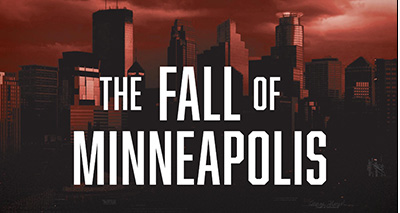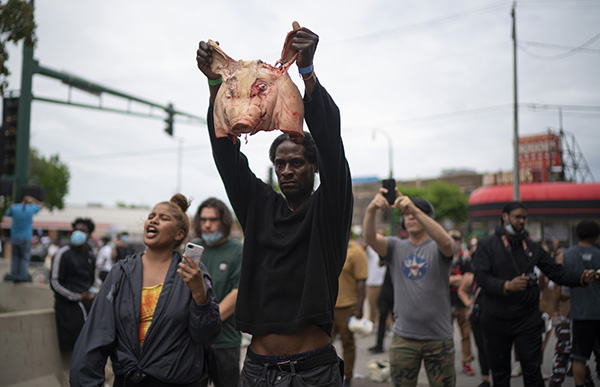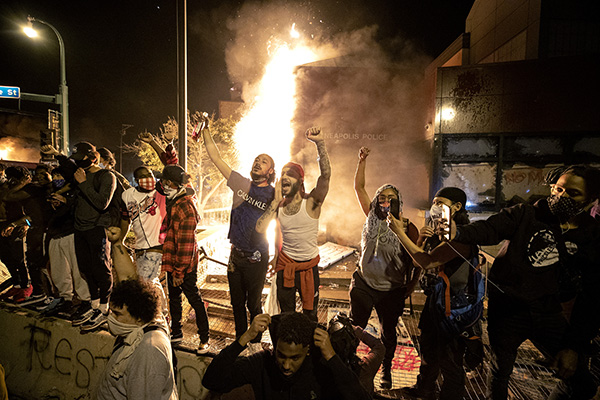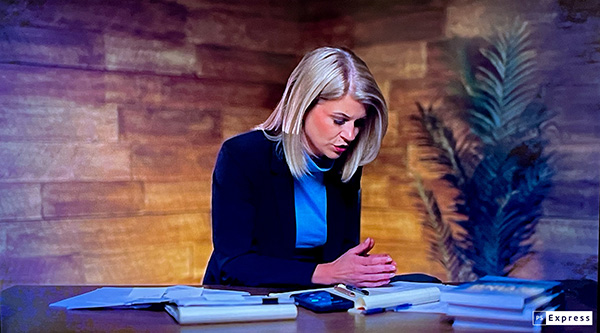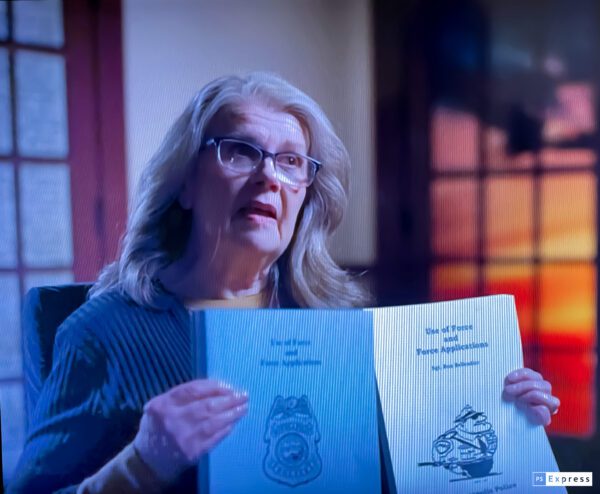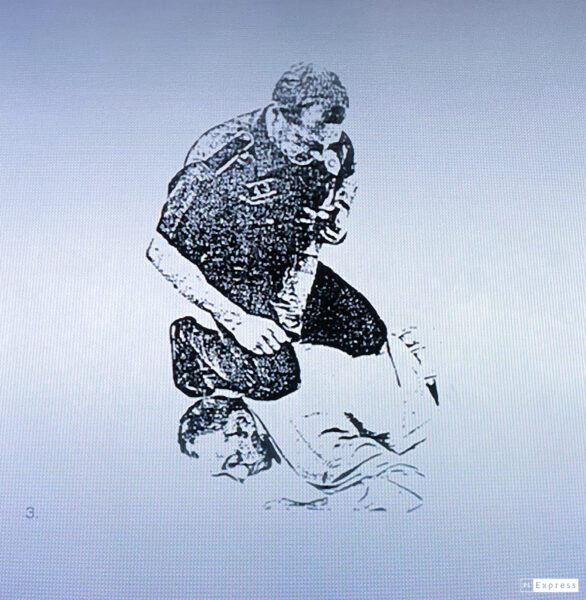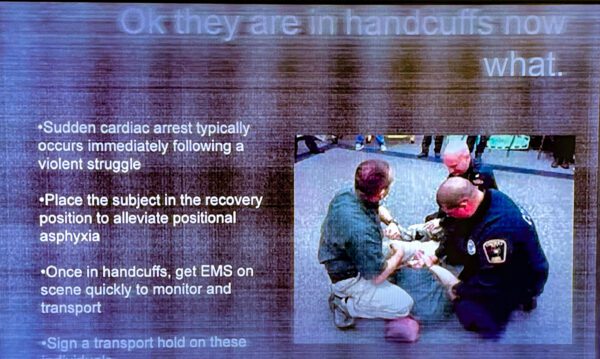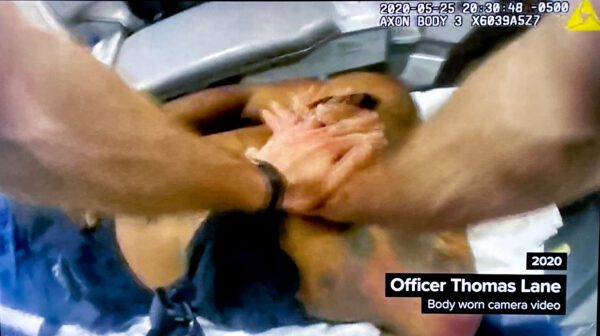Subscribe to future audio versions of AmRen articles here.
In 2021, I covered the trial of Derek Chauvin, the former Minneapolis police officer convicted of murdering George Floyd, for American Renaissance. Now, a documentary about the trial and the effects of Floyd’s death on policing in Minneapolis has been released. The Fall of Minneapolis was produced by investigative reporter Liz Collin, who based the film on her book They’re Lying: The Media, The Left and the Death of George Floyd. It is free on Rumble and YouTube.
The Fall of Minneapolis premiered on Rumble on November 16. As of December 7, it had more than three million views, 6,500 likes, and only 31 dislikes. Released on YouTube on November 23, by the same date it had 478,000 views and 13,000 likes. The film uses interviews with several Minneapolis police officers (including Derek Chauvin and Alex Kueng, the black officer also convicted in Floyd’s death), news reels, and trial footage, to give a police officer’s view of the 2020 BLM riots.
The production values of the film are excellent, and it is exciting and at times heartbreaking. In less than two hours, you will learn key points of Mr. Chauvin’s defense and some facts that were never presented to the jury.
The film starts by saying it will show you what the politicians and media “don’t want you to see.” It documents the 10 times George Floyd was arrested for such things as drugs and armed robbery. His priors were not allowed as evidence, because they were considered prejudicial.
The film also shows the police bodycam footage the jury saw during Mr. Chauvin’s trial to show George Floyd’s arrest from the officer’s point of view. The infamous video taken by a bystander begins after four officers spent several minutes struggling with Floyd, trying to get him into a police car. People who have seen only the viral video will be surprised to see what happened before.
The film shows the moment when the car Mr. Floyd was driving was pulled over. He had two passengers, both black, and both came through unharmed. Drug dealers Morries Hall and Shawanda Hill had no trouble following the officers’ instructions, but Mr. Floyd did not cooperate at all. The documentary even shows Miss Hill shouting, “Stop resisting, Floyd!”
Floyd lied to the police several times. He told Officer Lane he was shot the last time he was arrested, and he said, “I just lost my mom, man,” although his mother died two years earlier. Officer Kueng asked Mr. Floyd if he was on drugs, and he replied, “No, nothing, man.” The bodycam footage shows Officer Kueng pulling a marijuana pipe out of Mr. Floyd’s pocket. Later in the film, reporter Liz Collin interviews a nurse who says that if he had told the truth about the drugs he had taken, that could have helped save his life.
These clips are very useful, but I think it would have been better to show the entire incident all the way through, so the audience could see exactly how it unfolded.
The documentary reminds viewers of some important facts brought up in trial:
- George Floyd began saying “I can’t breathe” while he was fighting the officers who were trying to get him into the squad car.
- Officer Lane called for an EMS ambulance 36 seconds after Floyd was on the ground.
- Methamphetamine and fentanyl were recovered from the car, and similar pills covered in his saliva and DNA were recovered from the back of the police car where he spat them out.
Liz Collin interviews Officer Scott Creighton, who had arrested Floyd in 2019. He did not shoot Floyd. The bodycam footage from that arrest is shown alongside video of Floyd’s 2020 arrest. “Everything was almost identical,” Officer Creighton tells her. Mr. Floyd refused to show his hands and was apparently eating drugs before surrendering.
The most heartbreaking part of The Fall of Minneapolis is called “The Fall of the 3rd Precinct.” It is worth watching the documentary just for this. Mrs. Collin interviews seven police officers who were ordered by Mayor Jacob Frey to abandon the precinct; all were all shaken by the experience. Their voices have not been heard before, and are a strong indictment of Mayor Frey’s cowardice and incompetence.
The police officers — most of whom are now retired — recalled how the crowd in the streets grew larger and became violent. Rioters threw bottles and rocks at one of them, Scott Creighton, breaking three of his teeth. Officer Al Williams said he was dodging water bottles, bricks, and Roman candles. Jason Reimer said, “It was crazy. It was like I was living in a third-world country. They [city government] let people . . . throw rocks, and bricks, and fire bombs, and we’re supposed to just put on a helmet and take that.”
The police, some of whom had decades of experience and had worked riots before, knew that the orders coming down were not typical. They were told not to wear riot gear and not to do anything about the mayhem. Cops watched people looting, throwing Molotov cocktails, and shooting, but they were not allowed to make arrests, only “observe and report.” Mr. Williams said, “I was wandering around aimlessly, waiting to be told what not to do next.”
The police were assured that there was a “plan in place,” but when Lieutenant Lindsay Herron asked what it was, she got no answer. On duty at the 3rd Precinct, she had asked for reinforcements, but wasn’t taken seriously: “There was no riot gear given to anyone at that point, and we’re in the middle of a war zone.” Mrs. Herron estimates that 30 officers from her precinct were injured because they weren’t allowed to wear protective gear.
Eventually, Lt. Herron got the assistant chief on the phone, and he told her the plan was to make the precinct look abandoned, because if no one was there, it would not be a target. She recalls wondering, “How is this the plan? There’s thousands of protesters. There’s thousands of rioters. There’s dead pigs [laid in the street] in front of us. That signifies they will kill a cop.”
A man holding a pig’s head in the direction of Minneapolis police behind a barricade in the parking lot outside the Minneapolis Police Department’s Third Precinct office. (Credit Image: © Jeff Wheeler/TNS via ZUMA Press Wire)
Tim Hanks, a black officer, was ordered to remove firearms and ammunition from the 3rd Precinct. Moving trucks arrived to empty everything out, and SWAT teams came to take out the police who were still inside. The SWAT leader asked Lt. Herron why they were evacuating, as he saw no reason to do so. Mrs. Herron tearfully recalled how they left the building and how they had to run a gauntlet for blocks before buses came to pick them up. “Cops do not run away,” she says.
Al Williams left in a squad car. He looked back and saw rioters rush the fence, climbing it until it collapsed. “It looked like a zombie movie,” he says. As his car pulled away, rioters broke all its windows.
The Minneapolis Third Police Precinct is set on fire during the third night of protests following the death of George Floyd. (Credit Image: © Carlos Gonzalez/TNS via ZUMA Press Wire)
Retired Sergeant Darrin Waletzki tells Mrs. Collin that cops were “running for their lives,” and there was “no plan of exit from the precinct.”
Everything left behind in the precinct was destroyed. In the film, Mayor Frey says the precinct was just a building, but Mr. Hanks said it was “home” to the cops who worked there. Mayor Frey does not appear to realize that it was also a vital symbol of order.
In the documentary, the 3rd Precinct officers explain that the bitterness of that day caused most of them to retire. The city government’s policies and anti-police attitudes from the public had made their jobs much harder. Their police careers ranged from 21–37 years of service. Tim Hanks retired because he “felt helpless” and was having panic attacks.
Scott Creighton, a white officer, worried that he would be “the next Chauvin.” He had been injured twice on the job, and feared that he would “end up in prison” for doing his job.
Jason Reimer describes the “horrible day” he decided to retire. “Anytime we were out dealing with anybody, especially if the person was colored, we were getting all kinds of screaming and yelling and everything else.” He and several other cops were dealing with a large black suspect who was high on drugs, fighting the police when they tried to cuff him. Mr. Reimer says, “I’m thinking to myself, if this guy ODs, if this guy dies in custody — four white cops – at 17th and Chicago, 20 blocks from George Floyd – we’re going to prison!”
Lindsay Herron retired because going to work became so stressful it made her physically ill. She got a knot in her stomach, and felt like she would vomit as she drove to work in the morning.
Kim Voss, whose office was burned by rioters, retired after 37 years of service. She told Mrs. Collin that another officer gave her a ride home in a squad car at the end of her last day of work. A person on the street flipped them off as they drove by, and she thought to herself that she made the right decision. She felt betrayed by the mayor, the police chief, and the city council.
The one police officer Mrs. Collin interviews who still works for the department is a black man who has been with the MPD 19 years. Sergeant Rich Walker says he stayed on because he could “not let evil win.” He believes that the decision to give up the 3rd Precinct was a failure that still affects the city today. He notes that crime is way up — Mayor Frey insists it is down — and that the police can’t keep up. Mrs. Collin cites crime stats and shows that the number of officers in the MPD dropped from 892 in May 2020 to only 512 in October 2023.
The film shows Minneapolis city council member Jeremiah Ellison, son of Attorney General Keith Ellison, at a “Defund the Police” rally in 2020, promising his council will “dismantle the police department.” It did.
Comments by Dr. Andrew Baker, who performed George Floyd’s autopsy, are very important. He says Floyd had signs of untreated hypertension, which “can put you at risk for death.” He adds: “And certain intoxicants can exacerbate [that condition].” In another document, Dr. Baker notes that Floyd’s toxicology report showed a high amount of fentanyl in his system: “a fatal level of fentanyl under normal circumstances.”
He goes on to say, “If he were found dead at home alone and no other apparent causes, this could be acceptable to call an OD.” I think the filmmakers would have seemed more credible if they had not ignored his next sentence: “I am not saying this killed him.”
Hennepin County Prosecutor Amy Tamburino is the person who asked Dr. Baker to perform the autopsy. The film cites a deposition she gave last year in a sex discrimination lawsuit: “He [Dr. Baker] told me that there were no medical findings that showed any injury to the vital structures of Mr. Floyd’s neck. . . . He said to me, ‘Amy, what happens when the actual evidence doesn’t match up with the public narrative that everyone’s already decided on?’”
Mrs. Collin interviews surgeon Tom Haney, not associated with the case, about an article in the Journal of Clinical Medicine called “Possible Acromegaly Complicating the Death of George Floyd.” Asked by Mrs. Collin if officials were trying to hide this information, he says, “I’m not sure if the medical examiners were trying to hide it, but it seems like the prosecutor team was trying to hide it.” The article was published in September 2022, nearly a year and a half after Derek Chauvin’s trial.
For me, the most disappointing part of the film is Liz Collin’s phone interview with Derek Chauvin in prison. It seems much too short, but that may be because Mr. Chauvin has to be tight-lipped while his case is under appeal.
Liz Collin interviewing Derek Chauvin by phone.
Mr. Chauvin blames Floyd’s death on Emergency Medical Service’s slow response: “EMS and fire response was not normal. Normally, both those resources are sent. They arrive in short time, especially on a Code 3 situation. In this case, Minneapolis Fire took 20 minutes plus to arrive and their station is eight blocks away.”
The filmmakers back up Mr. Chauvin by showing testimony from Genevieve Hansen, an off-duty firefighter who showed up when Mr. Chauvin and the other officers had Floyd on the ground. She admitted she was surprised the EMS response was so slow. She knew there was a station nearby, and EMS would normally come more quickly. The documentary shows bodycam video of a paramedic saying they first went to a wrong location.
The film accuses Judge Cahill of stacking the deck against Mr. Chauvin by refusing to admit evidence about the Maximal Restraint [neck] Technique (MRT). Derek Chauvin told Mrs. Collin — correctly — that MRT was in the policy manual.
The Fall of Minneapolis does a good job of dispelling the “knee on the neck” myth that many news outlets repeated, by showing the part of the trial where bodycam footage shows Officer Chauvin’s knee was actually on George Floyd’s shoulder blade, and it only appeared to be on his neck.
Derek Chauvin’s mother holding her son’s police training manuals.
An illustration from the manual showing the Maximal Restraint Technique.
At the trial, Police Chief Medaria Arradondo was shown the screenshot of Mr. Chauvin taken from the bystander video, and he denied that this was a technique MPD trains officers to use. The police officers of the 3rd Precinct all disagree. The film includes a photo, routinely shown to officers during training, of three men restraining a suspect lying on his stomach. The image is very similar to how Derek Chauvin and two others restrained Floyd. We are told that the defense wanted to show that photo to the jury, but Judge Cahill wouldn’t allow it. It would have proven that the officers were using a technique MPD trained them to use.
The Fall of Minneapolis shows Thomas Lane doing CPR on George Floyd in the ambulance. I don’t remember seeing this at trial, although a paramedic did testify that Officer Lane did CPR. This video might have helped the jury understand that no one wanted to kill Floyd, or it might have made them wonder why no one did CPR sooner.
Mrs. Collin interviews a nurse named Debra Nelson, who noticed something wrong when she watched Officer Thomas Lane’s bodycam footage. She tells Mrs. Collin, “The paramedic handing the bag to Thomas Lane to ventilate the patient, you can see that the oxygen tubing is coiled up, it’s not even attached to the oxygen source. That’s a big mistake.”
Mrs. Collin interviewed Alex Kueng, the black officer who is now serving a 3½-year sentence. He says: “He [Chauvin] made the decision he thought was right. . . . He’s always been one that was by the book and legally abiding. I think he did exactly what he was trained to do. Unfortunate that the publicity got as riled up as it did by the officials and politicians that were involved with the case. And it took away all chance he had to say his piece.”
Mrs. Collin interviewed Alex Kueng’s mother, who believes the media downplayed her son’s involvement because “they couldn’t backpedal” on the story about racism. “They didn’t want to admit” that a black officer and an Asian officer were on the scene.
The film emphasizes how intimidating the environment was for jurors. The city had to prepare for more rioting if Mr. Chauvin were acquitted. Store windows were boarded up. The courthouse was protected with fences, barbed wire, concrete barriers, and National Guardsmen. Crowds of protesters gathered in front of the courthouse, screaming and chanting, high-profile politicians among them. Rep. Maxine Waters (D-CA) loudly told the news cameras, “We are looking for a guilty verdict!”
The city also announced — during jury selection — that it would pay George Floyd’s family $27 million to settle a civil lawsuit.
In spite of all this, Judge Cahill denied Mr. Chauvin a change of venue, arguing that everyone in the state had seen the press coverage. Not all had seen looting, vandalism, and watched a police precinct burn down.
Mr. Chauvin was convicted and sentenced to 22 years and 6 months and sent to a medium-security prison in Arizona. Last April, the Minnesota Court of Appeals upheld his conviction. On November 13, 2023, he filed a motion in federal court, asking that his conviction on federal civil rights charges be overturned. The motion will probably fail, because when Mr. Chauvin entered his guilty plea, he waived his right to appeal on any grounds except ineffective counsel. On November 20, the U.S. Supreme Court declined, without explanation, to hear his case.
On November 24, Mr. Chauvin was stabbed 22 times by another inmate, John Turscak, a 52-year-old member of the Mexican Mafia prison gang. Mr. Turscak told investigators he did it on “Black Friday” to symbolize Black Lives Matter. Mr. Chauvin was treated at a local hospital and has since been returned to the prison. His mother is angry the prison didn’t tell her sooner that her son had been attacked.
She also asks, “Is there a justice system in America? Not according to what they did to Derek and the other three officers. There isn’t any. I don’t believe in the justice system anymore.” Minneapolis has fallen, and so has the United States. Maybe films like this can set us back on course.
- Post TagsBlack Lives Matter, Featured, Non-White Pressure Groups, Riots
